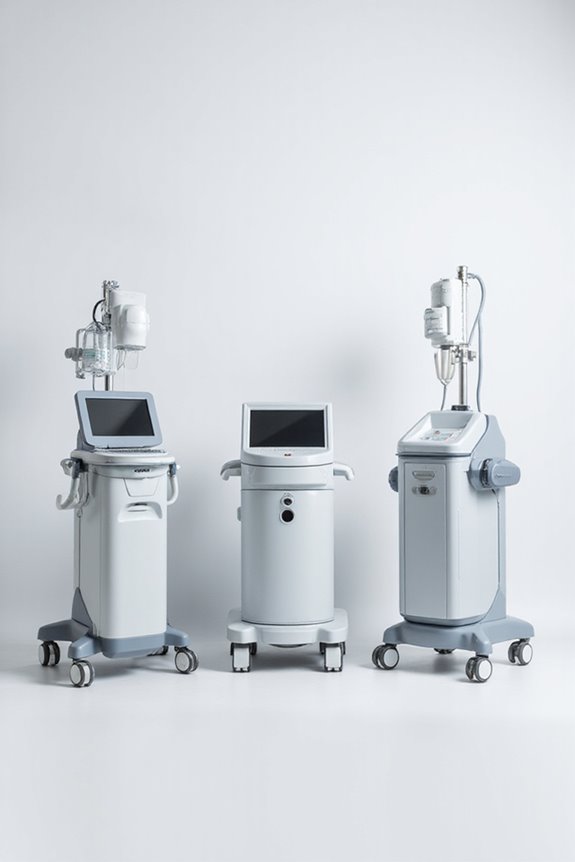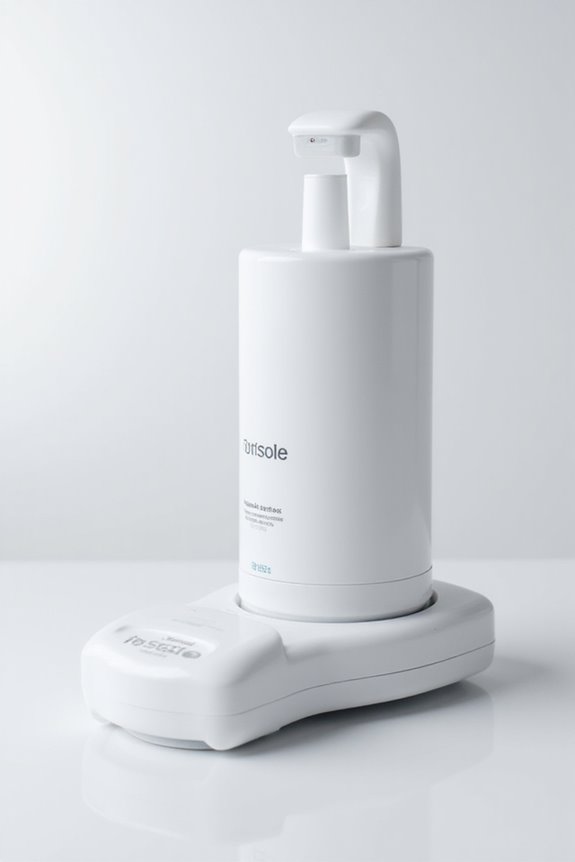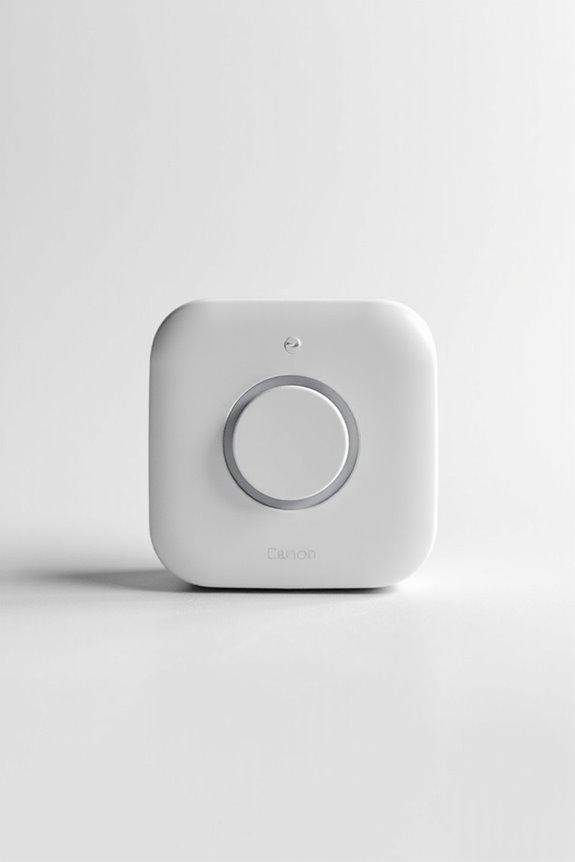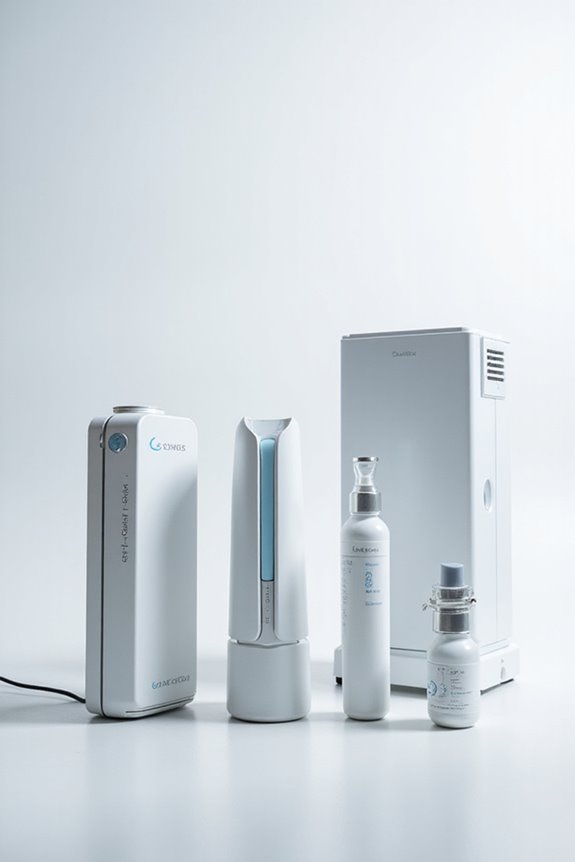As an Amazon Associate, we earn from qualifying purchases. Some links may be affiliate links at no extra cost to you. Although our opinions are based on curated research, we haven't used these products. Articles generated with AI.
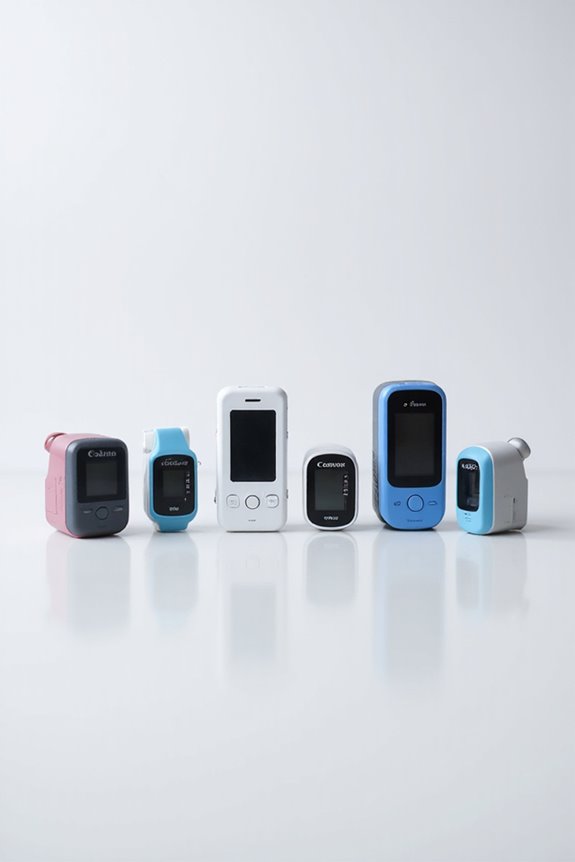
7 Best Pediatric Pulse Oximeters: Reliable Monitoring for Your Child’s Health
When selecting a pediatric pulse oximeter, consider accuracy, design, and user-friendliness. Look for devices with ±2% SpO2 accuracy, such as CHOICEMMED’s engaging frog and panda models, ideal for children aged 2.5 to 15. Features like quick charging USB-C batteries, high brightness OLED displays, and alarm settings enhance usability. Lightweight and portable designs guarantee easy transport. For a thorough overview of the best models and features, continue to explore the options available in the market.
Key Takeaways
- Look for pulse oximeters with high precision measurements, ensuring SpO2 accuracy of ±2% and pulse rate accuracy of ±2 bpm for reliable monitoring.
- Choose models featuring engaging designs (like frogs or pandas) to make monitoring enjoyable and less intimidating for children.
- Select devices that offer user-friendly one-button operation and clear OLED displays for easy readings by both children and caregivers.
- Consider oximeters with data logging capabilities, allowing parents to track up to 384 hours of readings without needing WiFi.
- Ensure the pulse oximeter is suitable for children aged 2.5 to 15 years, prioritizing comfort and engaging features to promote compliance.
Pediatric Pulse Oximeter for Kids (Rechargeable, USB-C Charging)
Yohcuro Fingertip Pluse Oximeter for Small Fingers, USB-C Rechargeable Oxygen Monitor, Cute Cartoon...
- 【Quick Reading for Active Lifestyles】 Get instant oxygen and pulse readings in seconds—perfect for sports enthusiasts, travelers, or anyone curious about their...
- 【USB-C Rechargeable】 With USB-C charging and a bright TFT screen, this sensor is designed for on-the-go use and easy viewing in various lighting conditions.
- 【Kid-Friendly Design with Fun Look】 Featuring a cute cartoon design and a snug silicone chamber ideal for smaller fingers, this device adds a touch of fun to casual...
The Pediatric Pulse Oximeter for Kids (Rechargeable, USB-C Charging) is specifically designed for children, making it an ideal choice for parents monitoring their child’s oxygen levels.
- High Precision Measurement:
- SpO2 accuracy ±2%
- Pulse rate accuracy ±2 bpm
- Convenience Features:
- USB-C rechargeable battery
- Quick charging capabilities
- Compact and lightweight design
- User-friendly Design:
- One-button operation
- Rotatable TFT display
- Auto turn-off after 12 seconds of inactivity
This pulse oximeter is tested against commercial-grade models, ensuring reliability for effective monitoring.
Best For: Parents looking for an effective and stress-relieving way to monitor their children’s oxygen levels.
Pros:
- High precision measurements with ±2% accuracy for SpO2 and ±2 bpm for pulse rate.
- Compact and lightweight design, making it easy to transport and store.
- User-friendly with a one-button operation and a bright, rotatable TFT display.
Cons:
- Not intended for medical use, primarily suitable for sports and aviation purposes.
- Concerns about the durability of the spring mechanism reported by some users.
- Quality may vary, with some experiencing long-term reliability issues.
Children Fingertip Pulse Oximeter Blood Oxygen Saturation Monitor
Children Fingertip Pulse Oximeter Blood Oxygen Saturation Monitor for Child Kids Portable Oxygen...
- Developed for baby: this baby oxygen monitor fits for kids, when you measure, your finger and body do not tremble during measuring. pls keep still, avoid measurement...
- Two aaa batteries power supply design: this kids pulse oximeter use 2 batteries power supply, batteries Included in the package, which is convenient and fast, pls note...
- Accurate fast reading:you just need to clipping the baby pulse oximeter on the finger, press power botton wait 8s, your finger and body do not want tremble during...
Children aged 2.5 to 15 years benefit greatly from the compact and lightweight design of the Children Fingertip Pulse Oximeter.
Product Overview
- Made from soft silicone for enhanced comfort.
- Colorful appearance appeals to children.
- OLED screen displays clear SpO₂ and heart rate readings.
Performance
- Delivers quick and accurate readings if the child remains still.
- Automatically powers off after 10 seconds of inactivity.
User Considerations
- Operated with 2 AAA batteries, included in the package.
- Limited suitability for toddlers under 3 years.
- Lacks Bluetooth and mobile app syncing capabilities.
Best For: Children aged 2.5 to 15 years who need to monitor their blood oxygen saturation and heart rate.
Pros:
- Compact and lightweight design that is easy for children to handle.
- Soft silicone material enhances comfort during use.
- Clear OLED screen provides easily readable SpO₂ and heart rate readings.
Cons:
- Not suitable for infants or toddlers under 3 years as it may not fit small fingers.
- Lacks Bluetooth connectivity and mobile app features for tracking health over time.
- Some users reported reliability issues after multiple battery changes.
CHOICEMMED OLED Frog Pediatric Pulse Oximeter for Kids
No products found.
Designed specifically for kids, the CHOICEMMED OLED Frog Pediatric Pulse Oximeter stands out as an excellent choice for parents looking to monitor their children’s blood oxygen levels.
Product Overview:
- Measures SpO2 and pulse rate (PR).
- Engaging frog design appeals to children.
- Suitable for children but not infants.
User-Friendly Features:
- One-button operation simplifies use.
- Color OLED screen offers real-time readings.
- Six display modes and adjustable brightness enhance visibility.
Safety and Accuracy:
- Provides accurate readings with SpO2 waveforms.
- Battery-low indicator guarantees functionality.
Customer Experiences:
– Generally positive feedback regarding performance and engagement.
Best For: Parents looking for a fun and effective way to monitor their children’s blood oxygen levels.
Pros:
- User-friendly: One-button operation and a color OLED display make it easy for parents and children to use.
- Engaging design: The frog shape captures children’s interest, making measurement a more enjoyable experience.
- Portable and convenient: Lightweight design with a neck lanyard included for easy carrying.
Cons:
- Durability concerns: Some users have reported issues with the durability of components.
- Suitability limitations: Not designed for infants or newborns, which may limit its audience.
- Mixed reviews on completeness: Some customers have noted missing items upon delivery.
CHOICEMMED OLED Panda Pediatric Pulse Oximeter for Kids
CHOICEMMED OLED Panda Pediatric Pulse Oximeter Fingertip – SP02 Pulse Oximeter for Kids –...
- Designed for Children: Our panda pediatric pulse oximeter is easy to use and has an efficient One Button Operation. Our fingertip pulse oximeter for kids will provide...
- Safe and Dependable: Our accurate children pulse oximeter has SpO2 waveforms in 4 directions, 6 display modes, and 10 levels of adjustable brightness. Comes with a...
- Out of Box Ready: Our portable kids pulse oximeter fingertip comes with an instruction manual, 2 AAA alkaline batteries and pulse oximeter case, you'll be ready to use...
When evaluating options for pediatric pulse oximeters, the CHOICEMMED OLED Panda model stands out for its thoughtful design that caters specifically to young users.
Product Overview
- Operation: One-button functionality simplifies use.
- Readings: Displays SpO2, PR, and pulse bar graph.
Safety and Dependability
- Display Modes: Six display options enhance usability.
- Brightness: Ten adjustable brightness settings.
- Battery Indicator: Alerts users to low battery levels.
User-Friendly Features
- Included Accessories: Comes with batteries and a lanyard.
- Portability: Compact design for easy transport.
Customer Feedback
- Reliability: Preferred by parents and healthcare professionals.
- Durability: Reported to withstand multiple washes.
Best For: The CHOICEMMED OLED Panda Pediatric Pulse Oximeter is best for parents seeking an easy-to-use, reliable device to monitor their child’s oxygen levels during sports or aviation activities.
Pros:
- User-Friendly: The one-button operation makes it simple for parents to use.
- Durability: Designed to withstand wear and tear, including accidental washes.
- Attractive Design: The panda theme engages children, promoting cooperation during usage.
Cons:
- Non-Medical Use: It is not intended for medical purposes, limiting its effectiveness in clinical settings.
- Limited Functionality: Primarily designed for children, may not suit older users or adults.
- Requires Batteries: Operates on AAA batteries that need to be replaced periodically.
New Version Kids Pulse Oximeter Fingertrip for Children
VOLUETH New Version Kids Pulse Oximeter Fingertrip, Blood Oxygen Saturation for Children, Portable...
- 【4-in-1 Kids Pulse Oximeter】VOLUETH is the Professional Finger Oximeter that uses a micro chip of advanced technology to obtain accurate results of the Kids oxygen...
- 【Upgraded Hardware and Software】Alerts you when your reading exceeds the set limit, beeps with each detected pulse, (this is turned off by default) and adjustable...
- 【Easy to operate】Just put the finger in to measure, press the button to start, take out the finger to automatically shut down. Your kids can learn to use pulse...
The VOLUETH Kids Pulse Oximeter is an ideal choice for young patients aged 2 and up, providing a reliable solution for monitoring critical health metrics.
Product Overview and Features:
- 4-in-1 device: measures oxygen saturation, heartbeat, respiratory rate, perfusion index, sphygmic wave.
- Upgraded hardware/software: alerts for critical readings, audible beeps, adjustable brightness.
- Suitable for children only; not for newborns or infants.
User Experience:
- Simple operation: insert finger, press button, automatic shutdown post-removal.
- OLED display delivers results in 8 seconds, ensuring clarity.
- Lightweight, portable, includes 2 AAA batteries, and lanyard.
Best For: The VOLUETH Kids Pulse Oximeter is best for parents looking to monitor their children’s vital health metrics in a fun and reliable way.
Pros:
- 4-in-1 functionality allows for comprehensive health monitoring by measuring oxygen saturation, heartbeat, respiratory rate, and more.
- User-friendly design with an easy operation and quick reading time of 8 seconds enhances convenience for both parents and children.
- Adorable animal theme and comfortable finger clip design make it appealing and easy to use for children.
Cons:
- May have accuracy concerns when used on larger fingers or toes, limiting effectiveness primarily to children’s fingers.
- Not suitable for infants or newborns, which could restrict its usability for families with younger children.
- Some users might find the need for additional batteries as a minor inconvenience for ongoing use.
CMI Health Rechargeable Pulse Oximeter for Infant and Adult Monitoring
No products found.
For those needing a reliable solution for monitoring both infants and adults, the CMI Health Rechargeable Pulse Oximeter stands out as an ideal choice. This device offers continuous monitoring for infants (up to 25 lbs) and spot-checking for adults.
Key Features:
- Accuracy: Pulse rate accurate to 2 bpm; SpO2 levels accurate to ±3%.
- Data Logging: Records 384 hours without needing WiFi.
- Alarm Settings: Adjustable thresholds for pulse rate and SpO2.
User Experience:
- Battery Life: Lasts 10-12 hours continuously.
- Portability: Compact and travel-friendly design.
Support:
– Warranty: 1-year limited warranty; US-based customer support.
Best For: Those seeking a reliable and portable pulse oximeter for monitoring both infants and adults at home or on the go.
Pros:
- Accurate readings for pulse rate and SpO2 levels.
- Long battery life (10-12 hours) for continuous use.
- User-friendly design with data logging capabilities.
Cons:
- Constant beeping can be distracting for some users.
- Non-compatible with non-CMI Health sensors.
- Lack of WiFi connectivity for real-time monitoring.
Pulse Oximeter for Kids, Vibeat Fingertip Blood Oxygen Meter
Pulse Oximeter for Kids, Vibeat Fingertip Blood Oxygen Meter with Smart Reminder for Children Baby...
- Reliable and Accurate Infant Pulse Oximeter -- Specially designed for children 2-12 years old (with finger diameters of 0.3 "-0.44"). Accurately get the blood oxygen...
- Stay Peace of Mind with Smart Reminder -- Smart reminder will let you know when child's O2 level is lower than 88%, or pulse rates go above 120bpm or below 40bpm. Don't...
- Easy for Kids to Use -- Simply insert the finger and push the start button to measure, and remove the finger to trigger shut-off automatically. It's simple enough for...
Pediatric Pulse Oximeters, particularly the Vibeat Fingertip Blood Oxygen Meter, stands out as the ideal choice for children aged 2-12 years, accommodating finger diameters between 0.3 and 0.44 inches.
Key Features:
- Measures blood oxygen levels, pulse rate, and pulse wave within 6 seconds.
- FSA or HSA approved for convenience.
Smart Alerts:
- Notifies you if O2 levels fall below 88%, or pulse rates exceed 120 bpm or drop below 40 bpm.
- Includes a low battery indicator.
User-Friendly Design:
- Simplifies use for children; automatic shut-off feature enhances usability.
- Lightweight and features a soft silicone cushion for comfort.
Reliable Performance:
– High brightness OLED display provides clear readings, ensuring accuracy comparable to pediatrician devices.
Best For: The Vibeat Fingertip Blood Oxygen Meter is best for children aged 2-12 years who need reliable monitoring of their blood oxygen levels and pulse rates.
Pros:
- Accurate readings comparable to professional pediatric devices, giving parents peace of mind.
- Smart alerts notify parents of any critical changes in oxygen levels or pulse rates.
- Lightweight and comfortable design with a soft silicone cushion, making it easy and pleasant for children to use.
Cons:
- Some parents have expressed concerns about the material quality, which may not be as durable.
- Limited compatibility with larger fingers outside the specified diameter range.
- Awareness needed regarding battery life as low battery alerts could be overlooked.
Factors to Consider When Choosing a Pediatric Pulse Oximeter
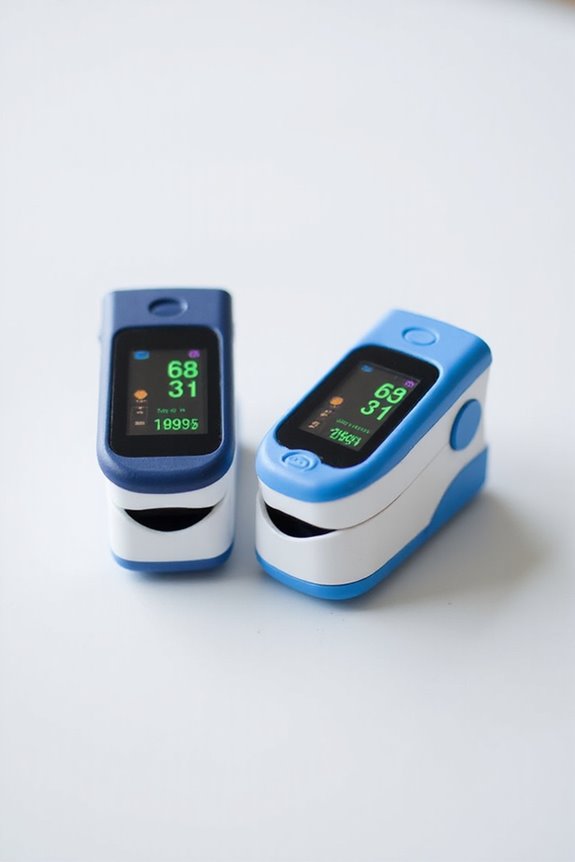
When selecting a pediatric pulse oximeter, you must consider several key factors to guarantee ideal performance. Accuracy of measurements is essential, as is a user-friendly design that accommodates children’s needs. Additionally, evaluate age appropriateness, battery life, portability, and weight to find the best fit for your situation.
Accuracy of Measurements
Accurate measurements are essential in pediatric pulse oximetry, as even slight deviations can impact clinical decisions. When choosing a pulse oximeter, consider the following factors:
- SpO2 and Pulse Rate Accuracy: Look for devices that provide an accuracy of ±2% for SpO2 and ±2 bpm for pulse rate.
- Child’s Movement: Be aware that a child’s movement can lead to inaccurate readings; try to keep them still during measurement.
- Quick Reading Capabilities: Some models offer results in just 6 to 8 seconds, ensuring efficient monitoring.
- Regular Calibration: Devices should be regularly calibrated against commercial-grade oximeters for consistent accuracy.
- Fit and Design: A snug fit enhances reliability and accuracy of measurements.
User-Friendly Design
User-friendly design is integral to the effectiveness of a pulse oximeter in pediatric care, as it guarantees that both healthcare providers and caregivers can operate the device with ease. Consider the following features:
- One-button operation simplifies usage for both children and parents.
- Clear display, ideally an OLED screen, provides easy-to-read SpO2 and pulse rate information in various lighting conditions.
- Lightweight and compact designs enhance portability, making storage and transport straightforward for families on the go.
- Comfortable finger chambers made of soft silicone assure a snug fit on small fingers without discomfort or pinching.
- Automatic shut-off feature conserves battery life and prevents unintentional use during inactivity.
These elements collectively enhance usability, essential for consistent monitoring in pediatric settings.
Age Appropriateness
Selecting an age-appropriate pediatric pulse oximeter is critical for accurate monitoring and comfort. When choosing a device, consider the following factors:
- Age Groups: Many models cater to specific age ranges—toddlers (2 years and older) or older children (up to 15 years).
- Finger Chamber Size: Devices for younger children feature smaller finger chambers to accommodate their digits, whereas those for older children may not suit infants.
- Accuracy and Reliability: Reading effectiveness can vary by age and size, influenced by design factors.
- Comfort: Younger children require designs that minimize discomfort to avoid intimidation.
- Safety and Standards: Verify the pulse oximeter meets established safety and performance guidelines for the intended age group.
Battery Life and Charging
Battery life is a fundamental aspect to evaluate when choosing a pediatric pulse oximeter.
- Battery longevity varies greatly; some devices offer rechargeable batteries lasting up to 12 hours on a single charge, while others use AAA batteries requiring frequent replacements.
- Opting for rechargeable models often guarantees convenience, especially with features like USB-C quick charging.
- Devices that power off after 10-12 seconds of inactivity help conserve battery life, a critical function for monitoring children.
- A low battery indicator is essential, alerting you when it’s time to recharge or replace the batteries, which avoids interruptions during use.
- Consider the ease of battery charging or replacement, as this greatly impacts usability for parents managing their child’s health monitoring.
Portability and Weight
Portability is an essential consideration when choosing a pediatric pulse oximeter, as it directly impacts your ability to monitor your child’s health in various settings.
- Lightweight designs make it easier to carry during travel or outings.
- Many models fit comfortably in a child’s hand or pocket, enhancing usability for quick checks.
- Compact units often feature one-button operation, simplifying use for both parents and children.
- A lighter construction reduces intimidation for young users, encouraging their participation in health monitoring.
- Most portable devices come with accessories like lanyards or carrying cases, enhancing convenience.
When selecting, prioritize these factors to guarantee efficient and effective monitoring, no matter where you are.
Comfort for Children
When monitoring your child’s health, comfort plays a significant role in their willingness to use a pediatric pulse oximeter. To guarantee your child is at ease, consider the following factors:
- Materials: Opt for models made from soft silicone to prevent pinching and discomfort during use.
- Weight and Size: Choose lightweight and compact devices for easier wear.
- User-Friendly Features: A one-button operation simplifies usage, reducing anxiety.
- Display Visibility: Bright displays with adjustable brightness enhance readability in various lighting conditions.
- Design Appeal: Look for fun themes, such as animals or cartoons, to engage your child and encourage cooperation.
Prioritizing comfort not only promotes compliance but also guarantees accurate readings, essential for monitoring your child’s health effectively.
Durability and Build Quality
Durability and build quality are crucial considerations when selecting a pediatric pulse oximeter, as these devices must endure frequent handling and potential impacts from active children.
- Opt for models made from high-quality materials like soft silicone, which guarantee comfort and resistance to wear and tear.
- Features like detachable neck lanyards can enhance durability by preventing accidental drops.
- Investigate user feedback regarding device longevity; concerns often arise about the durability of the spring mechanism and other components over time.
- Additionally, a well-constructed pulse oximeter should include a battery-low indicator. This feature guarantees reliability and avoids unexpected shutdowns during critical monitoring periods.
Choosing a durable pulse oximeter is crucial for effective health management.
Frequently Asked Questions
How Do I Clean and Maintain a Pediatric Pulse Oximeter?
Cleaning and maintaining a pediatric pulse oximeter is essential for accurate readings. Here’s how to do it:
- Disinfect: Wipe the device with a soft cloth dampened with mild disinfectant.
- Inspect: Regularly check for damage or wear on probes and sensors.
- Store: Keep it in a cool, dry place to prevent moisture damage.
What Is the Average Lifespan of a Pediatric Pulse Oximeter?
A pediatric pulse oximeter typically has a lifespan of about 2 to 5 years. Factors affecting lifespan include:
- Usage Frequency: Regular use may shorten lifespan.
- Maintenance: Proper cleaning and care can enhance longevity.
- Quality: High-quality devices often last longer.
It’s essential to monitor performance, as accuracy may decline over time. Always consult the manufacturer’s guidelines for specific maintenance recommendations.
Are There Any Side Effects From Using a Pulse Oximeter on Kids?
Using a pulse oximeter on kids is generally safe, but potential side effects can occur.
Possible Side Effects:
- Skin Irritation: Prolonged use may cause a rash or discomfort.
- False Readings: Factors like nail polish or movement can affect accuracy.
- Discomfort: Some kids may find the sensor uncomfortable or stress-inducing.
Can a Pulse Oximeter Be Used on Infants?
Yes, a pulse oximeter can be used on infants.
- Infants require properly-sized sensors for accurate readings.
- These devices measure oxygen saturation levels in blood, providing essential health data.
- Safety guidelines include confirming the sensor fits snugly without restricting blood flow.
Consult your pediatrician for recommendations on the appropriate device and usage instructions to confirm accuracy and comfort. Regular monitoring can facilitate early detection of potential health issues.
How Accurate Are Pediatric Pulse Oximeters Compared to Adult Models?
Pediatric pulse oximeters typically have a similar accuracy rate to adult models, often exceeding 95%. However, several factors affect this:
- Size and Fit: Pediatric devices are designed for smaller fingers.
- Technology: Most use similar technology, such as light absorption.
- Calibration: Proper calibration is essential for accurate readings.
When selecting a model, verify it meets FDA standards to confirm reliability in measuring oxygen saturation levels.






